Business Communication Report: Mr. Fishy Restaurant Analysis, London
VerifiedAdded on 2021/02/19
|8
|2894
|32
Report
AI Summary
This report analyzes the business communication practices at Mr. Fishy, a fish and chips restaurant in London, addressing challenges arising from Brexit, cultural differences, and staff communication issues. It examines linguistic, psychological, emotional, physical, cultural, organizational, attitude, and perception barriers. The report devises strategies to overcome these barriers, including using plain language, translation, visual aids, and organizational structure improvements. It differentiates between formal and informal communication, evaluating their purposes and applications within the restaurant. The report also discusses the application of communication principles like consistency, clarity, and feedback, along with an evaluation of communication practices and their impact on decision-making, leadership, morale, and action planning. Finally, it emphasizes the importance of cultural influences on communication and negotiation.
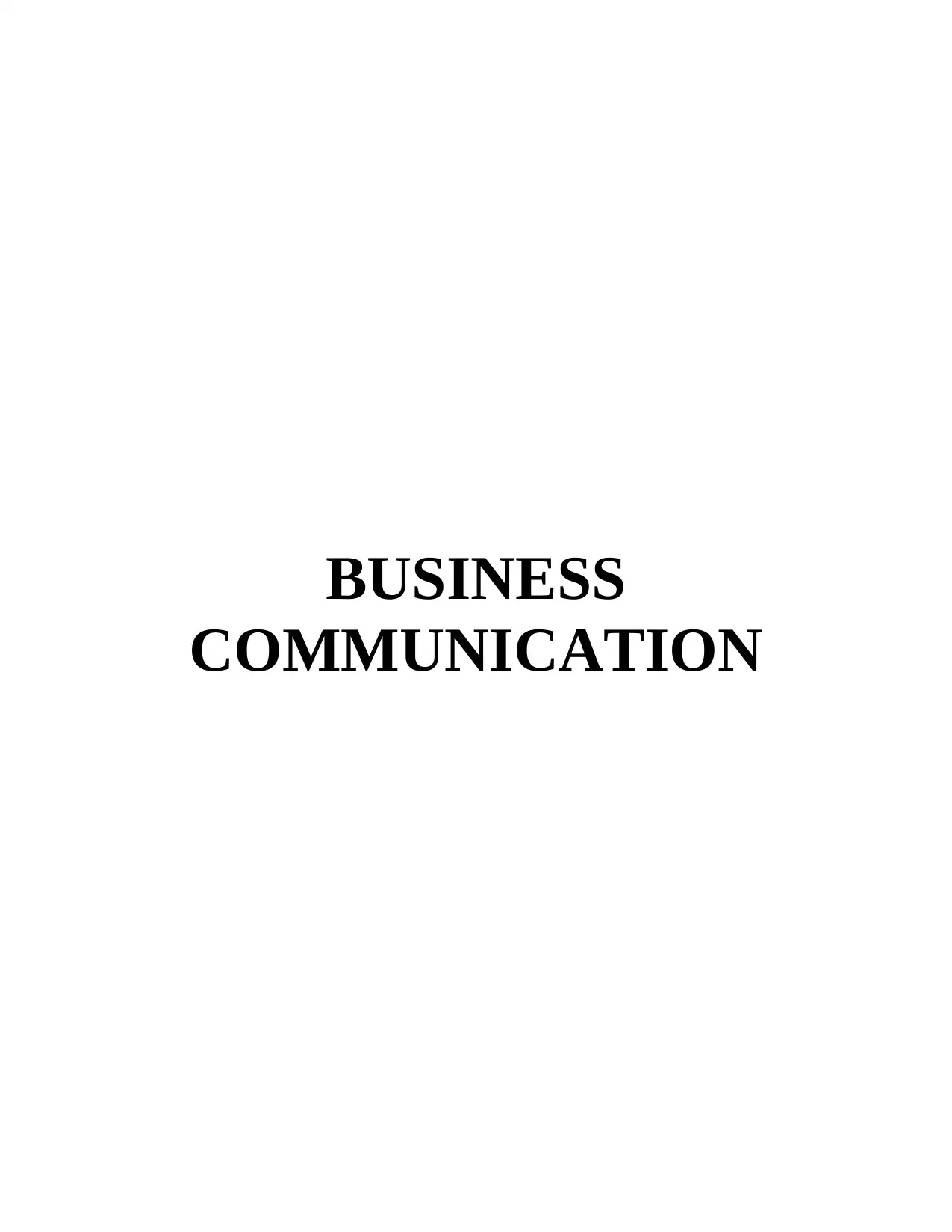
BUSINESS
COMMUNICATION
COMMUNICATION
Paraphrase This Document
Need a fresh take? Get an instant paraphrase of this document with our AI Paraphraser
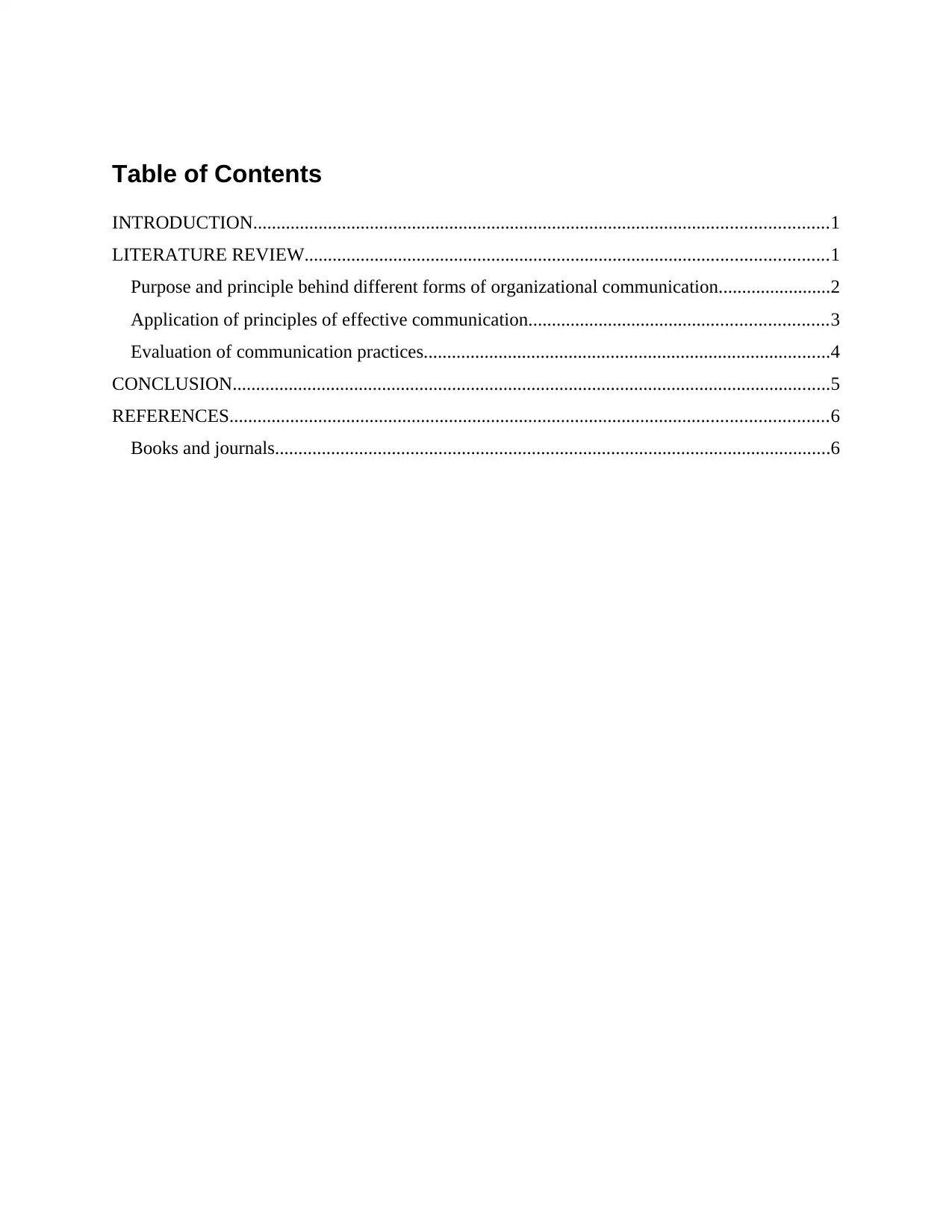
Table of Contents
INTRODUCTION...........................................................................................................................1
LITERATURE REVIEW................................................................................................................1
Purpose and principle behind different forms of organizational communication........................2
Application of principles of effective communication................................................................3
Evaluation of communication practices.......................................................................................4
CONCLUSION................................................................................................................................5
REFERENCES................................................................................................................................6
Books and journals.......................................................................................................................6
INTRODUCTION...........................................................................................................................1
LITERATURE REVIEW................................................................................................................1
Purpose and principle behind different forms of organizational communication........................2
Application of principles of effective communication................................................................3
Evaluation of communication practices.......................................................................................4
CONCLUSION................................................................................................................................5
REFERENCES................................................................................................................................6
Books and journals.......................................................................................................................6
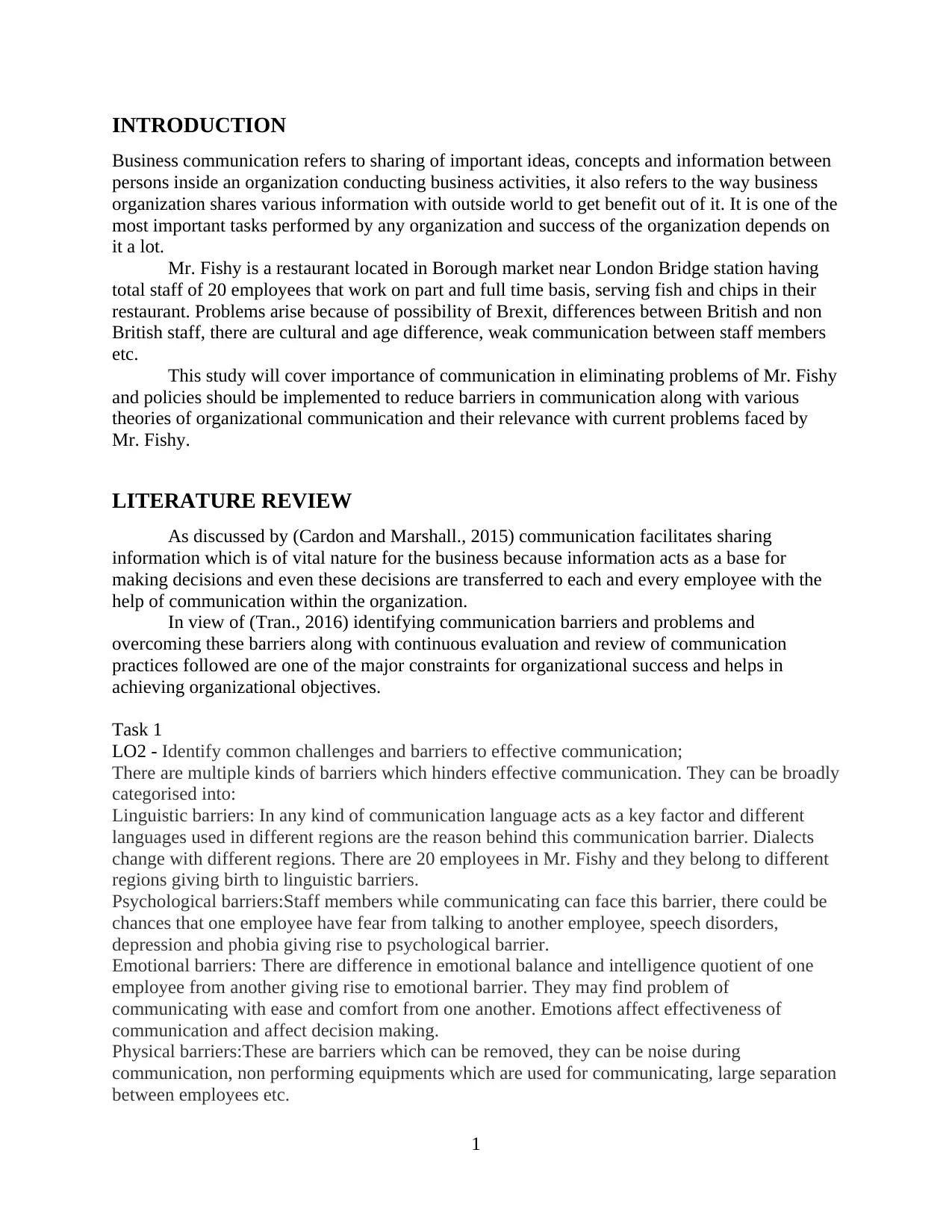
INTRODUCTION
Business communication refers to sharing of important ideas, concepts and information between
persons inside an organization conducting business activities, it also refers to the way business
organization shares various information with outside world to get benefit out of it. It is one of the
most important tasks performed by any organization and success of the organization depends on
it a lot.
Mr. Fishy is a restaurant located in Borough market near London Bridge station having
total staff of 20 employees that work on part and full time basis, serving fish and chips in their
restaurant. Problems arise because of possibility of Brexit, differences between British and non
British staff, there are cultural and age difference, weak communication between staff members
etc.
This study will cover importance of communication in eliminating problems of Mr. Fishy
and policies should be implemented to reduce barriers in communication along with various
theories of organizational communication and their relevance with current problems faced by
Mr. Fishy.
LITERATURE REVIEW
As discussed by (Cardon and Marshall., 2015) communication facilitates sharing
information which is of vital nature for the business because information acts as a base for
making decisions and even these decisions are transferred to each and every employee with the
help of communication within the organization.
In view of (Tran., 2016) identifying communication barriers and problems and
overcoming these barriers along with continuous evaluation and review of communication
practices followed are one of the major constraints for organizational success and helps in
achieving organizational objectives.
Task 1
LO2 - Identify common challenges and barriers to effective communication;
There are multiple kinds of barriers which hinders effective communication. They can be broadly
categorised into:
Linguistic barriers: In any kind of communication language acts as a key factor and different
languages used in different regions are the reason behind this communication barrier. Dialects
change with different regions. There are 20 employees in Mr. Fishy and they belong to different
regions giving birth to linguistic barriers.
Psychological barriers:Staff members while communicating can face this barrier, there could be
chances that one employee have fear from talking to another employee, speech disorders,
depression and phobia giving rise to psychological barrier.
Emotional barriers: There are difference in emotional balance and intelligence quotient of one
employee from another giving rise to emotional barrier. They may find problem of
communicating with ease and comfort from one another. Emotions affect effectiveness of
communication and affect decision making.
Physical barriers:These are barriers which can be removed, they can be noise during
communication, non performing equipments which are used for communicating, large separation
between employees etc.
1
Business communication refers to sharing of important ideas, concepts and information between
persons inside an organization conducting business activities, it also refers to the way business
organization shares various information with outside world to get benefit out of it. It is one of the
most important tasks performed by any organization and success of the organization depends on
it a lot.
Mr. Fishy is a restaurant located in Borough market near London Bridge station having
total staff of 20 employees that work on part and full time basis, serving fish and chips in their
restaurant. Problems arise because of possibility of Brexit, differences between British and non
British staff, there are cultural and age difference, weak communication between staff members
etc.
This study will cover importance of communication in eliminating problems of Mr. Fishy
and policies should be implemented to reduce barriers in communication along with various
theories of organizational communication and their relevance with current problems faced by
Mr. Fishy.
LITERATURE REVIEW
As discussed by (Cardon and Marshall., 2015) communication facilitates sharing
information which is of vital nature for the business because information acts as a base for
making decisions and even these decisions are transferred to each and every employee with the
help of communication within the organization.
In view of (Tran., 2016) identifying communication barriers and problems and
overcoming these barriers along with continuous evaluation and review of communication
practices followed are one of the major constraints for organizational success and helps in
achieving organizational objectives.
Task 1
LO2 - Identify common challenges and barriers to effective communication;
There are multiple kinds of barriers which hinders effective communication. They can be broadly
categorised into:
Linguistic barriers: In any kind of communication language acts as a key factor and different
languages used in different regions are the reason behind this communication barrier. Dialects
change with different regions. There are 20 employees in Mr. Fishy and they belong to different
regions giving birth to linguistic barriers.
Psychological barriers:Staff members while communicating can face this barrier, there could be
chances that one employee have fear from talking to another employee, speech disorders,
depression and phobia giving rise to psychological barrier.
Emotional barriers: There are difference in emotional balance and intelligence quotient of one
employee from another giving rise to emotional barrier. They may find problem of
communicating with ease and comfort from one another. Emotions affect effectiveness of
communication and affect decision making.
Physical barriers:These are barriers which can be removed, they can be noise during
communication, non performing equipments which are used for communicating, large separation
between employees etc.
1
⊘ This is a preview!⊘
Do you want full access?
Subscribe today to unlock all pages.

Trusted by 1+ million students worldwide
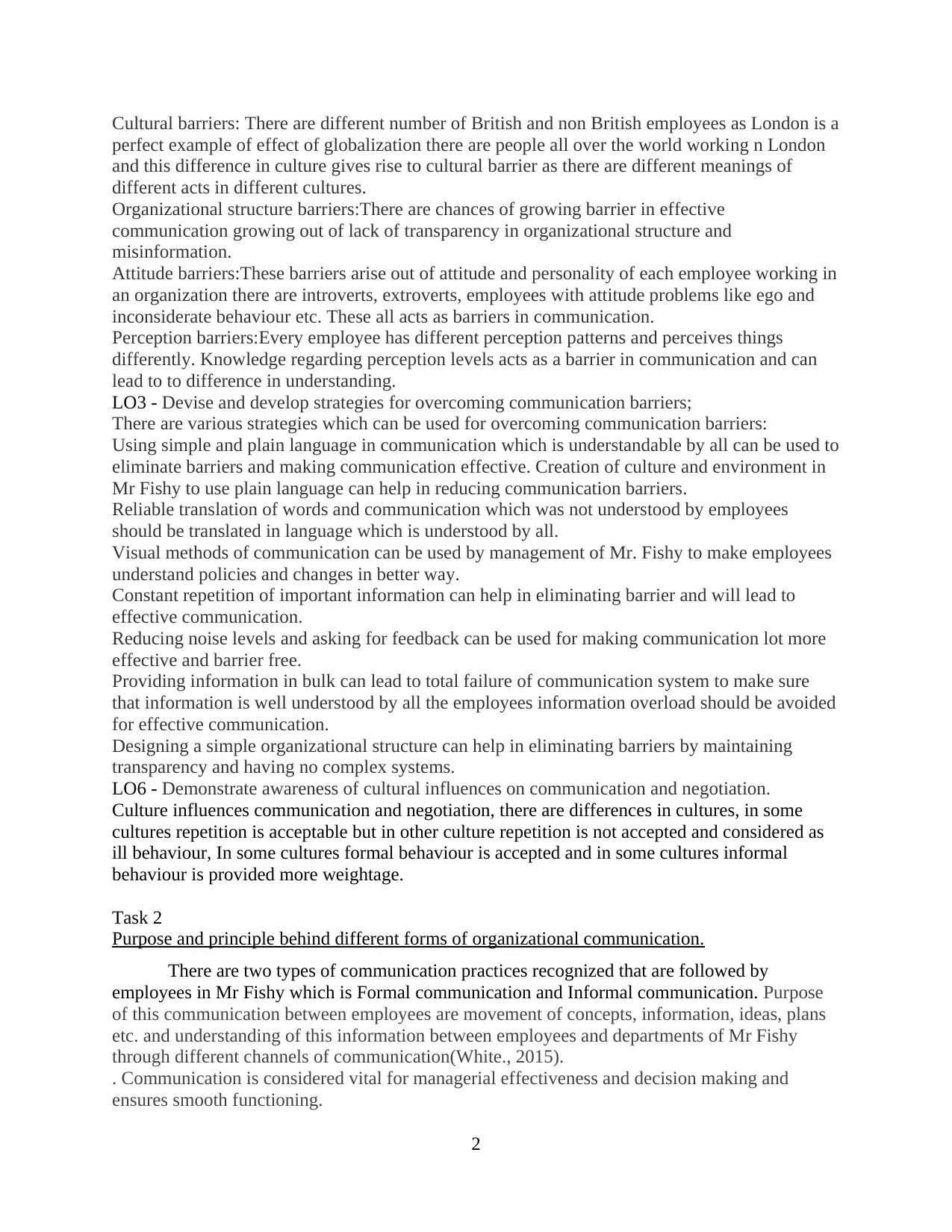
Cultural barriers: There are different number of British and non British employees as London is a
perfect example of effect of globalization there are people all over the world working n London
and this difference in culture gives rise to cultural barrier as there are different meanings of
different acts in different cultures.
Organizational structure barriers:There are chances of growing barrier in effective
communication growing out of lack of transparency in organizational structure and
misinformation.
Attitude barriers:These barriers arise out of attitude and personality of each employee working in
an organization there are introverts, extroverts, employees with attitude problems like ego and
inconsiderate behaviour etc. These all acts as barriers in communication.
Perception barriers:Every employee has different perception patterns and perceives things
differently. Knowledge regarding perception levels acts as a barrier in communication and can
lead to to difference in understanding.
LO3 - Devise and develop strategies for overcoming communication barriers;
There are various strategies which can be used for overcoming communication barriers:
Using simple and plain language in communication which is understandable by all can be used to
eliminate barriers and making communication effective. Creation of culture and environment in
Mr Fishy to use plain language can help in reducing communication barriers.
Reliable translation of words and communication which was not understood by employees
should be translated in language which is understood by all.
Visual methods of communication can be used by management of Mr. Fishy to make employees
understand policies and changes in better way.
Constant repetition of important information can help in eliminating barrier and will lead to
effective communication.
Reducing noise levels and asking for feedback can be used for making communication lot more
effective and barrier free.
Providing information in bulk can lead to total failure of communication system to make sure
that information is well understood by all the employees information overload should be avoided
for effective communication.
Designing a simple organizational structure can help in eliminating barriers by maintaining
transparency and having no complex systems.
LO6 - Demonstrate awareness of cultural influences on communication and negotiation.
Culture influences communication and negotiation, there are differences in cultures, in some
cultures repetition is acceptable but in other culture repetition is not accepted and considered as
ill behaviour, In some cultures formal behaviour is accepted and in some cultures informal
behaviour is provided more weightage.
Task 2
Purpose and principle behind different forms of organizational communication.
There are two types of communication practices recognized that are followed by
employees in Mr Fishy which is Formal communication and Informal communication. Purpose
of this communication between employees are movement of concepts, information, ideas, plans
etc. and understanding of this information between employees and departments of Mr Fishy
through different channels of communication(White., 2015).
. Communication is considered vital for managerial effectiveness and decision making and
ensures smooth functioning.
2
perfect example of effect of globalization there are people all over the world working n London
and this difference in culture gives rise to cultural barrier as there are different meanings of
different acts in different cultures.
Organizational structure barriers:There are chances of growing barrier in effective
communication growing out of lack of transparency in organizational structure and
misinformation.
Attitude barriers:These barriers arise out of attitude and personality of each employee working in
an organization there are introverts, extroverts, employees with attitude problems like ego and
inconsiderate behaviour etc. These all acts as barriers in communication.
Perception barriers:Every employee has different perception patterns and perceives things
differently. Knowledge regarding perception levels acts as a barrier in communication and can
lead to to difference in understanding.
LO3 - Devise and develop strategies for overcoming communication barriers;
There are various strategies which can be used for overcoming communication barriers:
Using simple and plain language in communication which is understandable by all can be used to
eliminate barriers and making communication effective. Creation of culture and environment in
Mr Fishy to use plain language can help in reducing communication barriers.
Reliable translation of words and communication which was not understood by employees
should be translated in language which is understood by all.
Visual methods of communication can be used by management of Mr. Fishy to make employees
understand policies and changes in better way.
Constant repetition of important information can help in eliminating barrier and will lead to
effective communication.
Reducing noise levels and asking for feedback can be used for making communication lot more
effective and barrier free.
Providing information in bulk can lead to total failure of communication system to make sure
that information is well understood by all the employees information overload should be avoided
for effective communication.
Designing a simple organizational structure can help in eliminating barriers by maintaining
transparency and having no complex systems.
LO6 - Demonstrate awareness of cultural influences on communication and negotiation.
Culture influences communication and negotiation, there are differences in cultures, in some
cultures repetition is acceptable but in other culture repetition is not accepted and considered as
ill behaviour, In some cultures formal behaviour is accepted and in some cultures informal
behaviour is provided more weightage.
Task 2
Purpose and principle behind different forms of organizational communication.
There are two types of communication practices recognized that are followed by
employees in Mr Fishy which is Formal communication and Informal communication. Purpose
of this communication between employees are movement of concepts, information, ideas, plans
etc. and understanding of this information between employees and departments of Mr Fishy
through different channels of communication(White., 2015).
. Communication is considered vital for managerial effectiveness and decision making and
ensures smooth functioning.
2
Paraphrase This Document
Need a fresh take? Get an instant paraphrase of this document with our AI Paraphraser
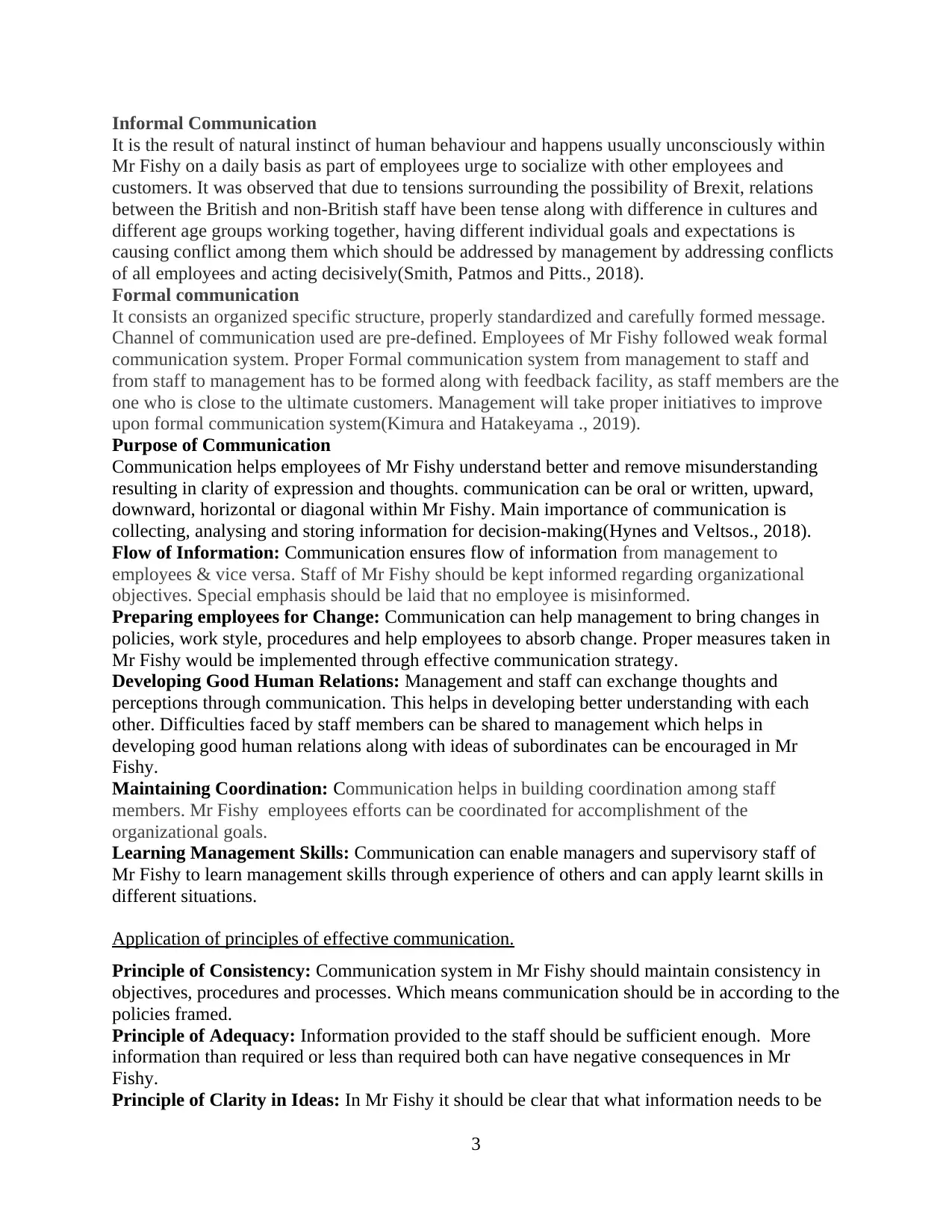
Informal Communication
It is the result of natural instinct of human behaviour and happens usually unconsciously within
Mr Fishy on a daily basis as part of employees urge to socialize with other employees and
customers. It was observed that due to tensions surrounding the possibility of Brexit, relations
between the British and non-British staff have been tense along with difference in cultures and
different age groups working together, having different individual goals and expectations is
causing conflict among them which should be addressed by management by addressing conflicts
of all employees and acting decisively(Smith, Patmos and Pitts., 2018).
Formal communication
It consists an organized specific structure, properly standardized and carefully formed message.
Channel of communication used are pre-defined. Employees of Mr Fishy followed weak formal
communication system. Proper Formal communication system from management to staff and
from staff to management has to be formed along with feedback facility, as staff members are the
one who is close to the ultimate customers. Management will take proper initiatives to improve
upon formal communication system(Kimura and Hatakeyama ., 2019).
Purpose of Communication
Communication helps employees of Mr Fishy understand better and remove misunderstanding
resulting in clarity of expression and thoughts. communication can be oral or written, upward,
downward, horizontal or diagonal within Mr Fishy. Main importance of communication is
collecting, analysing and storing information for decision-making(Hynes and Veltsos., 2018).
Flow of Information: Communication ensures flow of information from management to
employees & vice versa. Staff of Mr Fishy should be kept informed regarding organizational
objectives. Special emphasis should be laid that no employee is misinformed.
Preparing employees for Change: Communication can help management to bring changes in
policies, work style, procedures and help employees to absorb change. Proper measures taken in
Mr Fishy would be implemented through effective communication strategy.
Developing Good Human Relations: Management and staff can exchange thoughts and
perceptions through communication. This helps in developing better understanding with each
other. Difficulties faced by staff members can be shared to management which helps in
developing good human relations along with ideas of subordinates can be encouraged in Mr
Fishy.
Maintaining Coordination: Communication helps in building coordination among staff
members. Mr Fishy employees efforts can be coordinated for accomplishment of the
organizational goals.
Learning Management Skills: Communication can enable managers and supervisory staff of
Mr Fishy to learn management skills through experience of others and can apply learnt skills in
different situations.
Application of principles of effective communication.
Principle of Consistency: Communication system in Mr Fishy should maintain consistency in
objectives, procedures and processes. Which means communication should be in according to the
policies framed.
Principle of Adequacy: Information provided to the staff should be sufficient enough. More
information than required or less than required both can have negative consequences in Mr
Fishy.
Principle of Clarity in Ideas: In Mr Fishy it should be clear that what information needs to be
3
It is the result of natural instinct of human behaviour and happens usually unconsciously within
Mr Fishy on a daily basis as part of employees urge to socialize with other employees and
customers. It was observed that due to tensions surrounding the possibility of Brexit, relations
between the British and non-British staff have been tense along with difference in cultures and
different age groups working together, having different individual goals and expectations is
causing conflict among them which should be addressed by management by addressing conflicts
of all employees and acting decisively(Smith, Patmos and Pitts., 2018).
Formal communication
It consists an organized specific structure, properly standardized and carefully formed message.
Channel of communication used are pre-defined. Employees of Mr Fishy followed weak formal
communication system. Proper Formal communication system from management to staff and
from staff to management has to be formed along with feedback facility, as staff members are the
one who is close to the ultimate customers. Management will take proper initiatives to improve
upon formal communication system(Kimura and Hatakeyama ., 2019).
Purpose of Communication
Communication helps employees of Mr Fishy understand better and remove misunderstanding
resulting in clarity of expression and thoughts. communication can be oral or written, upward,
downward, horizontal or diagonal within Mr Fishy. Main importance of communication is
collecting, analysing and storing information for decision-making(Hynes and Veltsos., 2018).
Flow of Information: Communication ensures flow of information from management to
employees & vice versa. Staff of Mr Fishy should be kept informed regarding organizational
objectives. Special emphasis should be laid that no employee is misinformed.
Preparing employees for Change: Communication can help management to bring changes in
policies, work style, procedures and help employees to absorb change. Proper measures taken in
Mr Fishy would be implemented through effective communication strategy.
Developing Good Human Relations: Management and staff can exchange thoughts and
perceptions through communication. This helps in developing better understanding with each
other. Difficulties faced by staff members can be shared to management which helps in
developing good human relations along with ideas of subordinates can be encouraged in Mr
Fishy.
Maintaining Coordination: Communication helps in building coordination among staff
members. Mr Fishy employees efforts can be coordinated for accomplishment of the
organizational goals.
Learning Management Skills: Communication can enable managers and supervisory staff of
Mr Fishy to learn management skills through experience of others and can apply learnt skills in
different situations.
Application of principles of effective communication.
Principle of Consistency: Communication system in Mr Fishy should maintain consistency in
objectives, procedures and processes. Which means communication should be in according to the
policies framed.
Principle of Adequacy: Information provided to the staff should be sufficient enough. More
information than required or less than required both can have negative consequences in Mr
Fishy.
Principle of Clarity in Ideas: In Mr Fishy it should be clear that what information needs to be
3
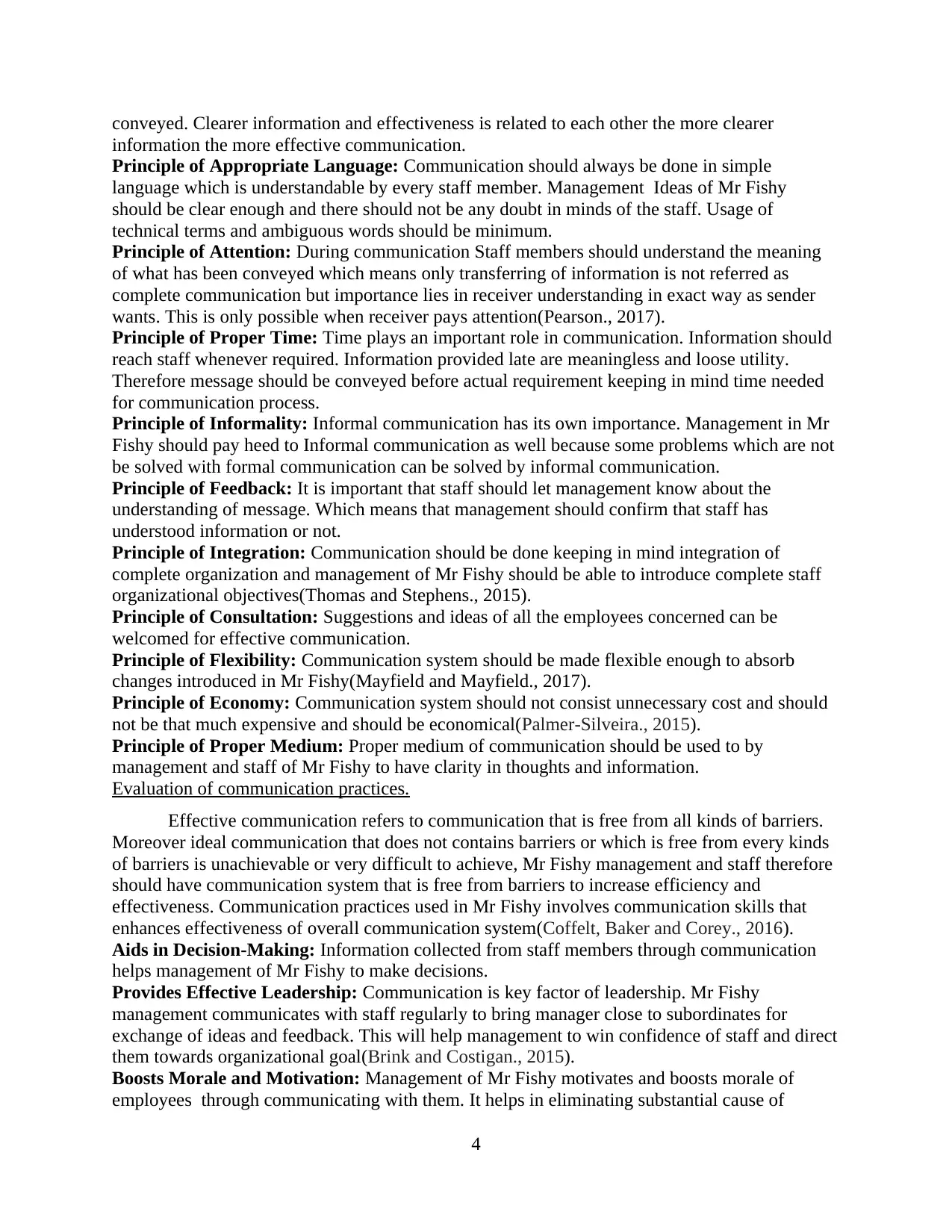
conveyed. Clearer information and effectiveness is related to each other the more clearer
information the more effective communication.
Principle of Appropriate Language: Communication should always be done in simple
language which is understandable by every staff member. Management Ideas of Mr Fishy
should be clear enough and there should not be any doubt in minds of the staff. Usage of
technical terms and ambiguous words should be minimum.
Principle of Attention: During communication Staff members should understand the meaning
of what has been conveyed which means only transferring of information is not referred as
complete communication but importance lies in receiver understanding in exact way as sender
wants. This is only possible when receiver pays attention(Pearson., 2017).
Principle of Proper Time: Time plays an important role in communication. Information should
reach staff whenever required. Information provided late are meaningless and loose utility.
Therefore message should be conveyed before actual requirement keeping in mind time needed
for communication process.
Principle of Informality: Informal communication has its own importance. Management in Mr
Fishy should pay heed to Informal communication as well because some problems which are not
be solved with formal communication can be solved by informal communication.
Principle of Feedback: It is important that staff should let management know about the
understanding of message. Which means that management should confirm that staff has
understood information or not.
Principle of Integration: Communication should be done keeping in mind integration of
complete organization and management of Mr Fishy should be able to introduce complete staff
organizational objectives(Thomas and Stephens., 2015).
Principle of Consultation: Suggestions and ideas of all the employees concerned can be
welcomed for effective communication.
Principle of Flexibility: Communication system should be made flexible enough to absorb
changes introduced in Mr Fishy(Mayfield and Mayfield., 2017).
Principle of Economy: Communication system should not consist unnecessary cost and should
not be that much expensive and should be economical(Palmer-Silveira., 2015).
Principle of Proper Medium: Proper medium of communication should be used to by
management and staff of Mr Fishy to have clarity in thoughts and information.
Evaluation of communication practices.
Effective communication refers to communication that is free from all kinds of barriers.
Moreover ideal communication that does not contains barriers or which is free from every kinds
of barriers is unachievable or very difficult to achieve, Mr Fishy management and staff therefore
should have communication system that is free from barriers to increase efficiency and
effectiveness. Communication practices used in Mr Fishy involves communication skills that
enhances effectiveness of overall communication system(Coffelt, Baker and Corey., 2016).
Aids in Decision-Making: Information collected from staff members through communication
helps management of Mr Fishy to make decisions.
Provides Effective Leadership: Communication is key factor of leadership. Mr Fishy
management communicates with staff regularly to bring manager close to subordinates for
exchange of ideas and feedback. This will help management to win confidence of staff and direct
them towards organizational goal(Brink and Costigan., 2015).
Boosts Morale and Motivation: Management of Mr Fishy motivates and boosts morale of
employees through communicating with them. It helps in eliminating substantial cause of
4
information the more effective communication.
Principle of Appropriate Language: Communication should always be done in simple
language which is understandable by every staff member. Management Ideas of Mr Fishy
should be clear enough and there should not be any doubt in minds of the staff. Usage of
technical terms and ambiguous words should be minimum.
Principle of Attention: During communication Staff members should understand the meaning
of what has been conveyed which means only transferring of information is not referred as
complete communication but importance lies in receiver understanding in exact way as sender
wants. This is only possible when receiver pays attention(Pearson., 2017).
Principle of Proper Time: Time plays an important role in communication. Information should
reach staff whenever required. Information provided late are meaningless and loose utility.
Therefore message should be conveyed before actual requirement keeping in mind time needed
for communication process.
Principle of Informality: Informal communication has its own importance. Management in Mr
Fishy should pay heed to Informal communication as well because some problems which are not
be solved with formal communication can be solved by informal communication.
Principle of Feedback: It is important that staff should let management know about the
understanding of message. Which means that management should confirm that staff has
understood information or not.
Principle of Integration: Communication should be done keeping in mind integration of
complete organization and management of Mr Fishy should be able to introduce complete staff
organizational objectives(Thomas and Stephens., 2015).
Principle of Consultation: Suggestions and ideas of all the employees concerned can be
welcomed for effective communication.
Principle of Flexibility: Communication system should be made flexible enough to absorb
changes introduced in Mr Fishy(Mayfield and Mayfield., 2017).
Principle of Economy: Communication system should not consist unnecessary cost and should
not be that much expensive and should be economical(Palmer-Silveira., 2015).
Principle of Proper Medium: Proper medium of communication should be used to by
management and staff of Mr Fishy to have clarity in thoughts and information.
Evaluation of communication practices.
Effective communication refers to communication that is free from all kinds of barriers.
Moreover ideal communication that does not contains barriers or which is free from every kinds
of barriers is unachievable or very difficult to achieve, Mr Fishy management and staff therefore
should have communication system that is free from barriers to increase efficiency and
effectiveness. Communication practices used in Mr Fishy involves communication skills that
enhances effectiveness of overall communication system(Coffelt, Baker and Corey., 2016).
Aids in Decision-Making: Information collected from staff members through communication
helps management of Mr Fishy to make decisions.
Provides Effective Leadership: Communication is key factor of leadership. Mr Fishy
management communicates with staff regularly to bring manager close to subordinates for
exchange of ideas and feedback. This will help management to win confidence of staff and direct
them towards organizational goal(Brink and Costigan., 2015).
Boosts Morale and Motivation: Management of Mr Fishy motivates and boosts morale of
employees through communicating with them. It helps in eliminating substantial cause of
4
⊘ This is a preview!⊘
Do you want full access?
Subscribe today to unlock all pages.

Trusted by 1+ million students worldwide
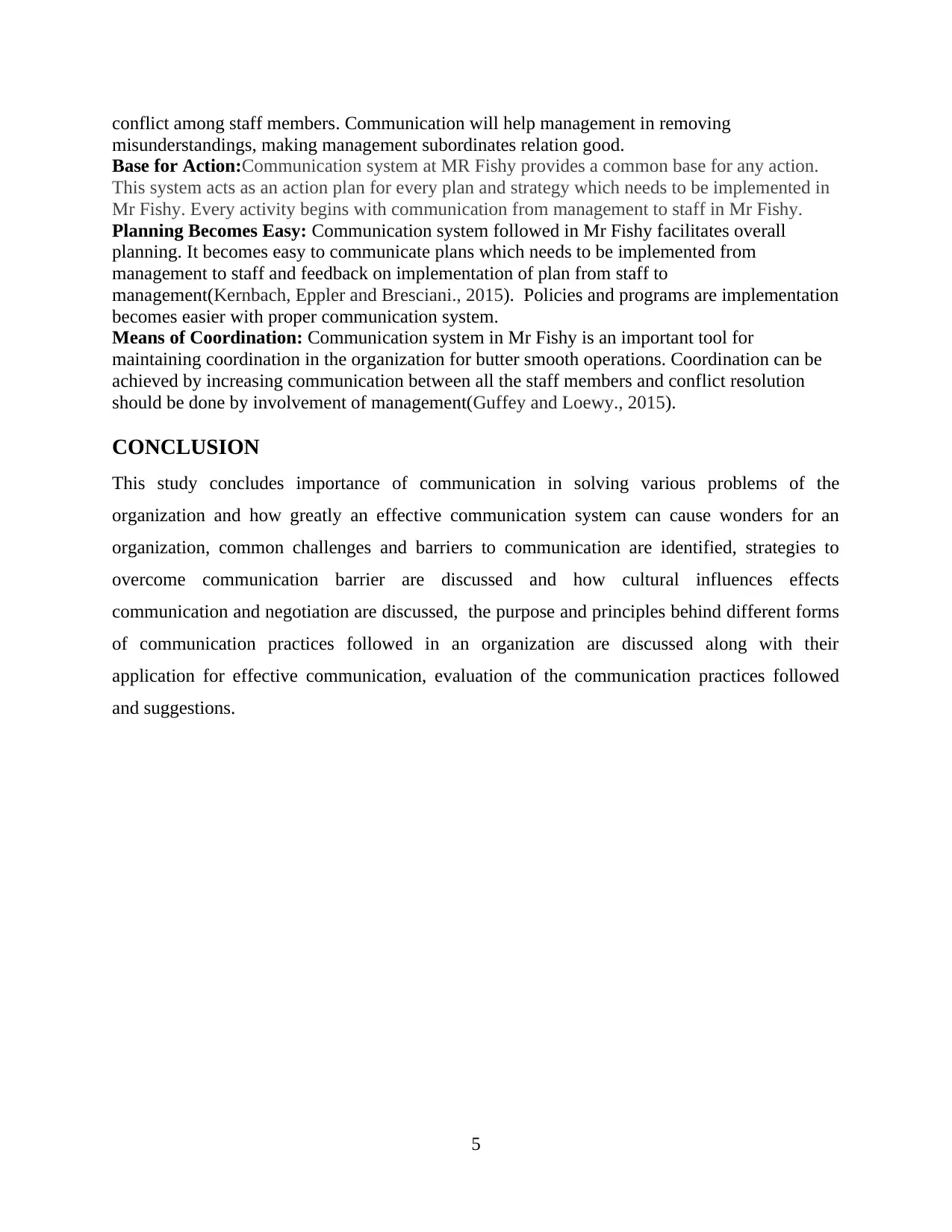
conflict among staff members. Communication will help management in removing
misunderstandings, making management subordinates relation good.
Base for Action:Communication system at MR Fishy provides a common base for any action.
This system acts as an action plan for every plan and strategy which needs to be implemented in
Mr Fishy. Every activity begins with communication from management to staff in Mr Fishy.
Planning Becomes Easy: Communication system followed in Mr Fishy facilitates overall
planning. It becomes easy to communicate plans which needs to be implemented from
management to staff and feedback on implementation of plan from staff to
management(Kernbach, Eppler and Bresciani., 2015). Policies and programs are implementation
becomes easier with proper communication system.
Means of Coordination: Communication system in Mr Fishy is an important tool for
maintaining coordination in the organization for butter smooth operations. Coordination can be
achieved by increasing communication between all the staff members and conflict resolution
should be done by involvement of management(Guffey and Loewy., 2015).
CONCLUSION
This study concludes importance of communication in solving various problems of the
organization and how greatly an effective communication system can cause wonders for an
organization, common challenges and barriers to communication are identified, strategies to
overcome communication barrier are discussed and how cultural influences effects
communication and negotiation are discussed, the purpose and principles behind different forms
of communication practices followed in an organization are discussed along with their
application for effective communication, evaluation of the communication practices followed
and suggestions.
5
misunderstandings, making management subordinates relation good.
Base for Action:Communication system at MR Fishy provides a common base for any action.
This system acts as an action plan for every plan and strategy which needs to be implemented in
Mr Fishy. Every activity begins with communication from management to staff in Mr Fishy.
Planning Becomes Easy: Communication system followed in Mr Fishy facilitates overall
planning. It becomes easy to communicate plans which needs to be implemented from
management to staff and feedback on implementation of plan from staff to
management(Kernbach, Eppler and Bresciani., 2015). Policies and programs are implementation
becomes easier with proper communication system.
Means of Coordination: Communication system in Mr Fishy is an important tool for
maintaining coordination in the organization for butter smooth operations. Coordination can be
achieved by increasing communication between all the staff members and conflict resolution
should be done by involvement of management(Guffey and Loewy., 2015).
CONCLUSION
This study concludes importance of communication in solving various problems of the
organization and how greatly an effective communication system can cause wonders for an
organization, common challenges and barriers to communication are identified, strategies to
overcome communication barrier are discussed and how cultural influences effects
communication and negotiation are discussed, the purpose and principles behind different forms
of communication practices followed in an organization are discussed along with their
application for effective communication, evaluation of the communication practices followed
and suggestions.
5
Paraphrase This Document
Need a fresh take? Get an instant paraphrase of this document with our AI Paraphraser
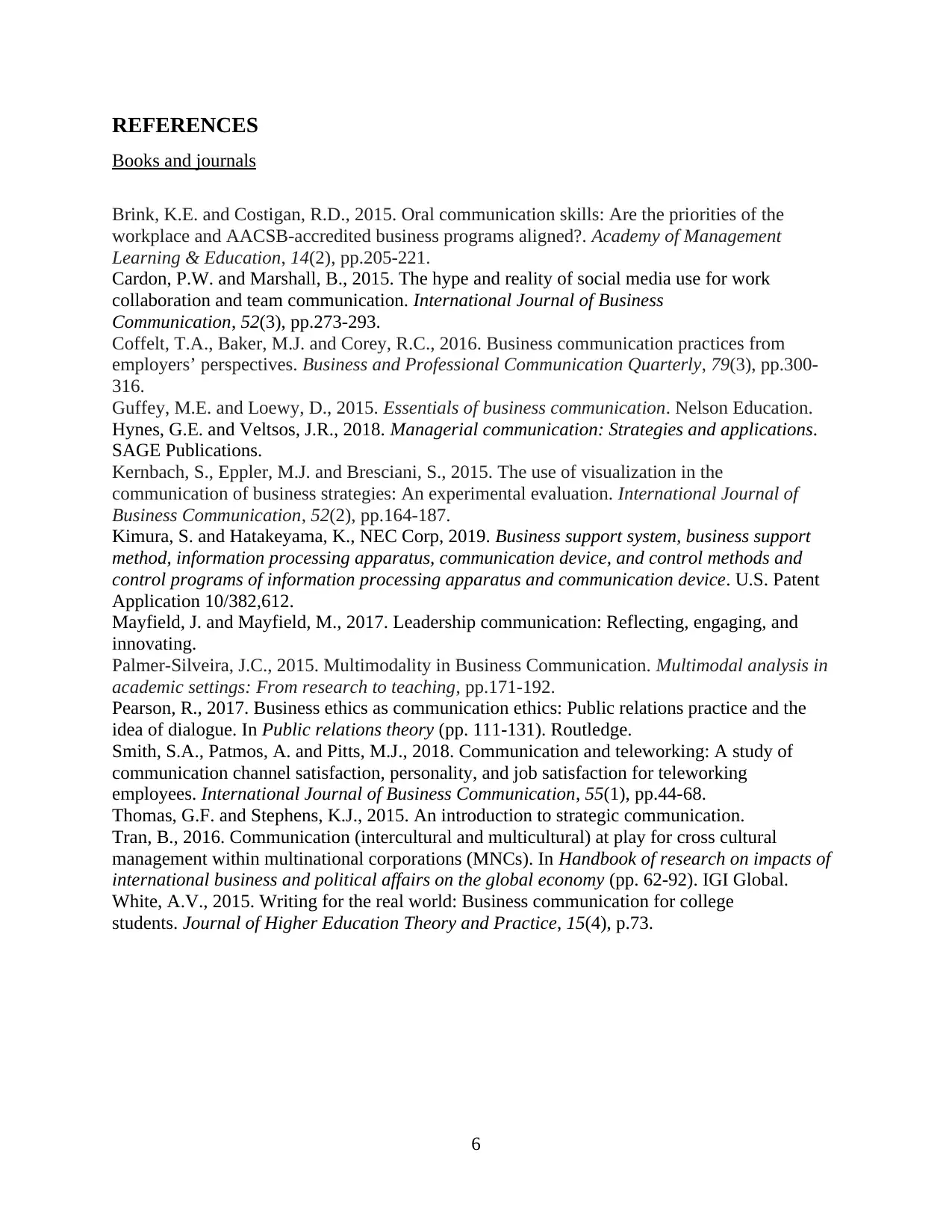
REFERENCES
Books and journals
Brink, K.E. and Costigan, R.D., 2015. Oral communication skills: Are the priorities of the
workplace and AACSB-accredited business programs aligned?. Academy of Management
Learning & Education, 14(2), pp.205-221.
Cardon, P.W. and Marshall, B., 2015. The hype and reality of social media use for work
collaboration and team communication. International Journal of Business
Communication, 52(3), pp.273-293.
Coffelt, T.A., Baker, M.J. and Corey, R.C., 2016. Business communication practices from
employers’ perspectives. Business and Professional Communication Quarterly, 79(3), pp.300-
316.
Guffey, M.E. and Loewy, D., 2015. Essentials of business communication. Nelson Education.
Hynes, G.E. and Veltsos, J.R., 2018. Managerial communication: Strategies and applications.
SAGE Publications.
Kernbach, S., Eppler, M.J. and Bresciani, S., 2015. The use of visualization in the
communication of business strategies: An experimental evaluation. International Journal of
Business Communication, 52(2), pp.164-187.
Kimura, S. and Hatakeyama, K., NEC Corp, 2019. Business support system, business support
method, information processing apparatus, communication device, and control methods and
control programs of information processing apparatus and communication device. U.S. Patent
Application 10/382,612.
Mayfield, J. and Mayfield, M., 2017. Leadership communication: Reflecting, engaging, and
innovating.
Palmer-Silveira, J.C., 2015. Multimodality in Business Communication. Multimodal analysis in
academic settings: From research to teaching, pp.171-192.
Pearson, R., 2017. Business ethics as communication ethics: Public relations practice and the
idea of dialogue. In Public relations theory (pp. 111-131). Routledge.
Smith, S.A., Patmos, A. and Pitts, M.J., 2018. Communication and teleworking: A study of
communication channel satisfaction, personality, and job satisfaction for teleworking
employees. International Journal of Business Communication, 55(1), pp.44-68.
Thomas, G.F. and Stephens, K.J., 2015. An introduction to strategic communication.
Tran, B., 2016. Communication (intercultural and multicultural) at play for cross cultural
management within multinational corporations (MNCs). In Handbook of research on impacts of
international business and political affairs on the global economy (pp. 62-92). IGI Global.
White, A.V., 2015. Writing for the real world: Business communication for college
students. Journal of Higher Education Theory and Practice, 15(4), p.73.
6
Books and journals
Brink, K.E. and Costigan, R.D., 2015. Oral communication skills: Are the priorities of the
workplace and AACSB-accredited business programs aligned?. Academy of Management
Learning & Education, 14(2), pp.205-221.
Cardon, P.W. and Marshall, B., 2015. The hype and reality of social media use for work
collaboration and team communication. International Journal of Business
Communication, 52(3), pp.273-293.
Coffelt, T.A., Baker, M.J. and Corey, R.C., 2016. Business communication practices from
employers’ perspectives. Business and Professional Communication Quarterly, 79(3), pp.300-
316.
Guffey, M.E. and Loewy, D., 2015. Essentials of business communication. Nelson Education.
Hynes, G.E. and Veltsos, J.R., 2018. Managerial communication: Strategies and applications.
SAGE Publications.
Kernbach, S., Eppler, M.J. and Bresciani, S., 2015. The use of visualization in the
communication of business strategies: An experimental evaluation. International Journal of
Business Communication, 52(2), pp.164-187.
Kimura, S. and Hatakeyama, K., NEC Corp, 2019. Business support system, business support
method, information processing apparatus, communication device, and control methods and
control programs of information processing apparatus and communication device. U.S. Patent
Application 10/382,612.
Mayfield, J. and Mayfield, M., 2017. Leadership communication: Reflecting, engaging, and
innovating.
Palmer-Silveira, J.C., 2015. Multimodality in Business Communication. Multimodal analysis in
academic settings: From research to teaching, pp.171-192.
Pearson, R., 2017. Business ethics as communication ethics: Public relations practice and the
idea of dialogue. In Public relations theory (pp. 111-131). Routledge.
Smith, S.A., Patmos, A. and Pitts, M.J., 2018. Communication and teleworking: A study of
communication channel satisfaction, personality, and job satisfaction for teleworking
employees. International Journal of Business Communication, 55(1), pp.44-68.
Thomas, G.F. and Stephens, K.J., 2015. An introduction to strategic communication.
Tran, B., 2016. Communication (intercultural and multicultural) at play for cross cultural
management within multinational corporations (MNCs). In Handbook of research on impacts of
international business and political affairs on the global economy (pp. 62-92). IGI Global.
White, A.V., 2015. Writing for the real world: Business communication for college
students. Journal of Higher Education Theory and Practice, 15(4), p.73.
6
1 out of 8
Related Documents
Your All-in-One AI-Powered Toolkit for Academic Success.
+13062052269
info@desklib.com
Available 24*7 on WhatsApp / Email
![[object Object]](/_next/static/media/star-bottom.7253800d.svg)
Unlock your academic potential
Copyright © 2020–2025 A2Z Services. All Rights Reserved. Developed and managed by ZUCOL.




